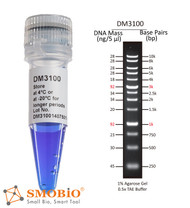Sizing Up DNA Ladders - These molecular rulers reveal the size of nucleotide fragments
Posted by Stellar Staff on 11th Dec 2018
A Penn State website notes that DNA ladders “are among the most commonly used reagents in molecular biology research.” Also known as DNA molecular weight markers, scientists use these reagents to measure the size of fragments composed of nucleotides.
That makes DNA ladders as important to a molecular biologist as a tape measure is to a carpenter. In other words, you can find these DNA ladders in about every molecular biologist’s toolbelt.
A DNA ladder consists of DNA fragments of known size, in base pairs (bp). These fragments create bands on a gel that—more or less—add a scale, like the tick marks on a ruler.
Samples of DNA fragments of unknown size in other lanes of a gel can be measured by comparison to the DNA-ladder ‘tick’ marks. For more details, see Gel Electrophoresis from the Khan Academy.
Sometimes, DNA ladders even get used for unexpected purposes. For example, biological chemist Jim Morrissey of the University of Michigan Medical School and his colleagues used DNA ladders to measure the size of inorganic polyphosphates (polyP) used in polyacrylamide gel electrophoresis (PAGE).
In 2018 in Electrophoresis, Morrissey and his colleagues reported: “This relationship between DNA and polyP size held for a variety of different polyacrylamide concentrations, indicating that DNA size ladders can readily be employed to estimate polyP polymer lengths by PAGE.”
That’s just one example of many. Making the most of these reagents, though, depends on having easy access to the best products.
Search for selection
A DNA ladder must address the correct size range of an application. As a distributor of molecular biology products from SMOBIO in Taiwan, we offer a range of DNA ladders that cover a wide range of sizes. SMOBIO’s DM2100 ExcelBand 100 bp DNA Ladder, for example, consists of 11 DNA fragments: 1,500, 1,000, 900, 800, 700, 600, 500, 400, 300, 200 and 100bp.
To provide easy references, the fragments at 1,500 and 500 bp create enhanced bands. The DM2300 ExcelBand 100 bp+3K DNA Ladder provides more range by adding a 3,000bp fragment, and the DM3200 ExcelBand 1 KB Plus (0.1-10 kb) DNA Ladder goes up to 10,000bp.
In addition to bp range, resolution matters. To create a ruler with a finer scale, the DM1100 ExcelBand 50 bp DNA Ladder includes 17 DNA markers: 1,500, 1,200, 1,000, 900, 800, 700, 600, 500, 450, 400, 350, 300, 250, 200, 150, 100, and 50bp.
All lab managers keep an eye on performance and cost. So the number of gel lanes that a DNA-ladder product can mark also matters. As an example, New Jersey-based Accuris Instruments offers its Accuris SmartCheck 1kb DNA Ladder—which includes 13 bands covering 250–10,000bp and reference bands at 1,000 and 3,000bp—in 100 and 500 lane versions.
For your next gel run, see if one of these reagents covers the range that you need, at the right resolution and covering the number of needs gels. Then, add the best tick marks to your gels to measure the DNA fragments in your samples.

